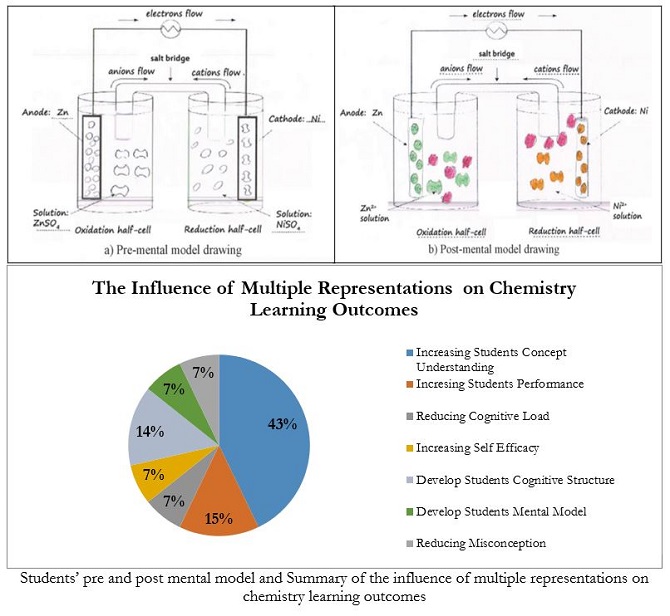
Chemistry Learning Using Multiple Representations: A Systematic Literature Review
Abstract
Full Text:
Download PDFReferences
Ainsworth, S. (2006). DeFT: A conceptual framework for considering learning with multiple representations. Learning and Instruction, 16(3), 183–198. https://doi.org/10.1016/j.learninstruc.2006.03.001
Baptista, M., Martins, I., Conceição, T., & Reis, P. (2019). Multiple representations in the development of students’ cognitive structures about the saponification reaction. Chemistry Education Research and Practice, 20(4), 760–771. https://doi.org/10.1039/c9rp00018f.
Bridle, C. A., & Yezierski, E. J. (2012). Evidence for the effectiveness of inquiry-based, particulate-level instruction on conceptions of the particulate nature of matter. Journal of Chemical Education, 89(2), 192–198. https://doi.org/10.1021/ed100735u.
Chandrasegaran, A. L., Treagust, D. F., & Mocerino, M. (2007). The development of a two-tier multiple-choice diagnostic instrument for evaluating secondary school students’ ability to describe and explain chemical reactions using multiple levels of representation. Chemistry Education Research and Practice, 8(3), 293–307. https://doi.org/10.1039/B7RP90006F
Chang, R., & Overby, J. (2011). General Chemistry, 6th ed. New York: The McGraw-Hill Companies, Inc.
Effendy.(2016). Ilmu Kimia Untuk Siswa SMA dan MA Jilid 1A [Chemistry for High School and MA Students Volume 1A]. Malang : Indonesia Academic Publishing.
Derman, A., & Ebenezer, J. (2020). The Effect of Multiple Representations of Physical and Chemical Changes on the Development of Primary Pre-service Teachers Cognitive Structures. Research in Science Education, 50(4), 1575–1601. https://doi.org/10.1007/s11165-018-9744-5.
Domin, D. & Bodner, G. (2004). Mental Models: The Role of Representations in Problem Solving in Chemistry. Proceedings, University Chemistry Education, 4(1) : 24-30.
Domin, D., and Bodner, G. (2012). Using students’ representations constructed during problem solving to infer conceptual understanding. Journal of Chemical Education, 89(7), 837–843. https://doi.org/10.1021/ed1006037.
Huddle, P. A., & Pillay, A. E. (1996). An In-Depth Study of Misconceptions in Stoichiometry and Chemical Equilibrium at a South African University. Journal of Research in Science Teaching: The Official Journal of the National Association for Research in Science Teaching, 33(1), 65-77.
Indriyanti, N. Y., Saputro, S., & Sungkar, R. L. (2020). Problem-Solving and Problem-Posing Learning Model Enriched With the Multiple Representation in Tetrahedral Chemistry To Enhance Students’ Conceptual Understanding. Edusains, 12(1), 123–134. https://doi.org/10.15408/es.v12i1.13282.
Johnstone, A. H. (1993). The Development of Chemistry Teaching. Journal of Chemical Education, 70(9), 701–705.
Kimberlin, S., & Yezierski, E. (2016). Effectiveness of Inquiry-Based Lessons Using Particulate Level Models to Develop High School Students’ Understanding of Conceptual Stoichiometry. Journal of Chemical Education, 93(6), 1002–1009. https://doi.org/10.1021/acs.jchemed.5b01010.
Lee, G., Kwon, J., Park, S. S., Kim, J. W., Kwon, H. G., & Park, H. K. (2003). Development of an instrument for measuring cognitive conflict in secondary-level science classes. Journal of Research in Science Teaching, 40(6), 585–603. https://doi.org/10.1002/tea.10099.
Mahaffy, P. (2006). Moving chemistry education into 3D: A tetrahedral metaphor for understanding chemistry: Union carbide award for chemical education. Journal of Chemical Education, 83(1), 49–55. https://doi.org/10.1021/ed083p49.
Milenković, D. D., Segedinac, M. D., & Hrin, T. N. (2014). Increasing high school students’ chemistry performance and reducing cognitive load through an instructional strategy based on the interaction of multiple levels of knowledge representation. Journal of Chemical Education, 91(9), 1409-1416.
Nakhleh, M. (1992). Why Some Students Don’t Learn Chemistry. Journal of Chemical Education, 69 (3), 191−196.
Nugrahaeni, A., Redhana, I. W., & Kartawan, I. M. A. (2017). Penerapan model pembelajaran discovery learning untuk meningkatkan kemampuan berpikir kritis dan hasil belajar kimia [Application of discovery learning learning model to improve critical thinking skills and chemistry learning outcomes]. Jurnal Pendidikan Kimia Indonesia, 1(1), 23-29.
Pikoli, M. (2020). Using guided inquiry learning with multiple representations to reduce misconceptions of chemistry teacher candidates on acid-base concept. International Journal of Active Learning, 5(1), 1-10.
Priyasmika, R. (2021). The Effect of Multiple Representation-Based Guided Inquiry on Learning Outcomes Reviewed from Scientific Thinking Skills. EduChemia (Jurnal Kimia dan Pendidikan), 6(1), 55-66. https://doi.org/10.30870/educhemia.v6i1.8985.
Rahayu, S., & Kita, M. (2010). An Analysis of Indonesian and Japanese Students’ Understandings of Macroscopic and Submicroscopic Levels of Representing Matter and its Changes. International Journal of Science and Mathematics Education, 8(4), 667–688. https://doi.org/10.1007/s10763-009-9180-0.
Santos, V. C., & Arroio, A. (2016). The representational levels: Influences and contributions to research in chemical education. Journal of Turkish Science Education (TUSED), 13(1).
Sirhan, G. (2007). Learning Difficulties in Chemistry: An Overview. Journal of Turkish Science Education, 4(2), 2−20.
Sunyono, S., & Meristin, A. (2018). The effect of multiple representation-based learning (MRL) to increase students’ understanding of chemical bonding concepts. Jurnal Pendidikan IPA Indonesia, 7(4), 399–406. https://doi.org/10.15294/jpii.v7i4.16219.
Sunyono, S., Leny, Y., & Muslimin, I. (2015). Supporting students in learning with multiple representation to improve student mental models on atomic structure concepts. Science Education International, 26(2), 104-125.
Supasorn, S. (2015). Grade 12 students’ conceptual understanding and mental models of galvanic cells before and after learning by using small-scale experiments in conjunction with a model kit. Chemistry Education Research and Practice, 16(2), 393–407. https://doi.org/10.1039/c4rp00247d.
Tima, M. T., & Sutrisno, H. (2018). Influence of Problem Solving Based on Multiple Representations Model on Teaching and Learning of Chemistry on Student Academic Self-Efficacy and Students’s Cognitive Achievement. American Journal of Educational Research, 6(7), 887-892.
Widarti, H. R., Marfu’ah, S., & Parlan. (2019). The Effects of Using Multiple Representations on Prospective Teachers’ Conceptual Understanding of Intermolecular Forces. Journal of Physics: Conference Series, 1227(1). https://doi.org/10.1088/1742-6596/1227/1/012006.
Widarti, H. R., Permanasari, A., Mulyani, S., Rokhim, D. A., & Habiddin, H. (2021). Multiple Representation-Based Learning through Cognitive Dissonance Strategy to Reduce Student’s Misconceptions in Volumetric Analysis. TEM Journal, 10(3), 1263–1273. https://doi.org/10.18421/tem103-33.
Wiyarsi, A., Sutrisno, H., & Rohaeti, E. (2018). The effect of multiple representation approach on students’ creative thinking skills: A case of “Rate of Reaction” topic. Journal of Physics: Conference Series, 1097(1). https://doi.org/10.1088/1742-6596/1097/1/012054.
Xiao, Y., & Watson, M. (2019). Guidance on Conducting a Systematic Literature Review. Journal of Planning Education and Research, 39(1), 93–112. https://doi.org/10.1177/0739456X17723971
DOI: https://doi.org/10.17509/jsl.v5i2.42656
Refbacks
- There are currently no refbacks.
Copyright (c) 2022 Margaretha Bhrizda Permatasari, Sri Rahayu, I Wayan Dasna

This work is licensed under a Creative Commons Attribution-ShareAlike 4.0 International License.


Jl. Dr. Setiabudhi 229 Bandung 40154, West Java, Indonesia










